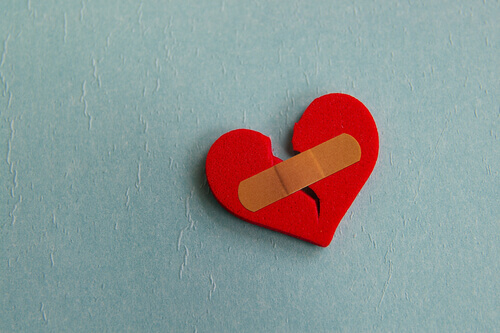Healing Means that Pain Stops Controlling your Life


Written and verified by the psychologist Valeria Sabater
Healing emotional wounds doesn’t mean forgetting. It means, more than anything, getting to the point where they don’t control your life. Something like this requires a meticulous process of transformation.
You have to understand that after this transformation, you won’t be the same anymore. Healing doesn’t mean going back in time, it means rebuilding and giving shape to something new, something stronger and more valuable.
We all have wounds that need attention. We live in a world full of different types of violence. Some are more explicit and others hidden and silent. Things like sexism, discrimination, bullying, physically intimidating or intimidation in social media, family dysfunction, or even cultural messages about beauty and success can all leave their mark.
“When reason finally understands what happened, the wounds on the heart are already too deep.”
-Carlos Ruiz Zafon-
In the last few centuries, western psychology has tried, with varying success, to heal these wounds with a wide variety of techniques. This is a science that is, at its heart, an effort to relieve pain and provide us with the proper techniques to improve our thought patterns and behavior. The over-arching goal is to make positive life changes.
However, none of this is possible if the patient isn’t willing. What happens very often is that instead of addressing the problem, whether that be an isolated incident or a traumatic past, people choose to ignore it. We clench our fists, close our hearts, and march forward without looking back.
As you can probably guess, this is a bad strategy. Another mistake we often make is to believe that time heals all wounds on its own. All we have to do is let the days, months, or years pass for things to resolve themselves. However, time doesn’t heal anything. What we do in that time is what does the healing.

Healing wounds: in search of primary pain
Alba is 30 years old. About 8 months ago, she lost her dad to a stroke. Everyone around her, including her partner, friends, and family are surprised at how she is dealing with her grief. She didn’t take any time off work. On the contrary, she became almost obsessively focused and started working at a frenetic pace.
No one has seen her cry or display any sort of emotional response. She is more active than ever. She barely stays in the house. It’s like she’s trying to keep herself busy all the time so she doesn’t have to think or feel. Nevertheless, she reaches a point of such exhaustion and stress that she decided to go to her primary care physician to get “something to help me sleep or relax.” Her doctor, however, decides to send her to a psychologist.
After an initial assessment with Alba, the psychologist can see two things very clearly. The first is that his patient hasn’t done any kind of grieving. The second is that she has created a very effective “survival” version of herself that is hiding a deep, primary pain.
Alba needs to heal her wounds, wounds that might go beyond just the loss of her father. There could be traumatic events from her past that were reactivated by the loss of her father. All of that combined made for an even more complex upheaval.

This story helps us understand two things that we will discuss further. When facing the experience of pain, emptiness, and confusion that traumatic events like abuse, loss, or mistreatment can cause, people often try to just turn the page and forget it. That’s why they create this “fake me,” a character that helps them stay afloat.
Nevertheless, the wound is still there, lying in wait. Little by little it will spread and even cause other, secondary wounds (isolation, personality disorders, anxiety, depression, etc…)
Emotional first aid
There’s a very interesting book called The Primal Wound by John Firman, that explains something as interesting as it is useful. Healing doesn’t mean erasing traumas. It is more about newly enabling ourselves as human beings. Most importantly, it is about creating an empathetic connection with that primal wound.
This last part might seem strange or complex. In order to understand it, you just have to remember something: when someone goes to therapy, the first thing that they will notice is the empathetic surroundings.
They are in a warm and intimate environment in which the psychologist is trying to connect to her patient. So, what the patient has to try to do is empathetically connect with his wounds and internal needs. He has to reconnect with all the pain that he has neglected and tried to ignore.
By doing this, we can heal this primary trauma and its secondary effects, little by little. It is a delicate process. Likewise, another thing that Dr. Firman explains in his book is the importance of knowing proper emotional first aid for all those “emotional cuts and bruises” that we suffer from every day. Let’s look at a few examples.

5 First-aid techniques to cure wounds
- Describe and be aware. The first piece of advice is not to put off until tomorrow what you could do today. Don’t ignore what’s troubling you today. The best way to do that is to know how to describe your emotional state. Words like “today I feel empty, angry, hurt, I’m scared, I feel alone, frustrated, etc.” can help.
- The second step is to not be dependent. You should understand and accept that no one deserves to be a victim of a traumatic wound, disappointment, or ongoing negative state of mind.
- The third step is to have compassion for yourself. No one should love you or worry as much about your pain as you. Feeling compassion means making the pain visible and understanding that it needs treatment and relief.
- A good support system. Though we might prefer it, it’s not always good to deal with our problems and everyday cuts and bruises on our own. Having a good support system that allows you to vent and express yourself is very helpful.
The last step is to change. Healing pain means making more than one change. It requires more than one adjustment on a personal level and in our surroundings to give way to something new. Sometimes, meeting new people, starting new projects, or trying a new hobby can be enough of an incentive to start dreaming again.
As the old Chinese Proverb says, if you fix your hair every day, why don’t you do the same with your heart? Healing your wounds is possible, let’s start today.
Healing emotional wounds doesn’t mean forgetting. It means, more than anything, getting to the point where they don’t control your life. Something like this requires a meticulous process of transformation.
You have to understand that after this transformation, you won’t be the same anymore. Healing doesn’t mean going back in time, it means rebuilding and giving shape to something new, something stronger and more valuable.
We all have wounds that need attention. We live in a world full of different types of violence. Some are more explicit and others hidden and silent. Things like sexism, discrimination, bullying, physically intimidating or intimidation in social media, family dysfunction, or even cultural messages about beauty and success can all leave their mark.
“When reason finally understands what happened, the wounds on the heart are already too deep.”
-Carlos Ruiz Zafon-
In the last few centuries, western psychology has tried, with varying success, to heal these wounds with a wide variety of techniques. This is a science that is, at its heart, an effort to relieve pain and provide us with the proper techniques to improve our thought patterns and behavior. The over-arching goal is to make positive life changes.
However, none of this is possible if the patient isn’t willing. What happens very often is that instead of addressing the problem, whether that be an isolated incident or a traumatic past, people choose to ignore it. We clench our fists, close our hearts, and march forward without looking back.
As you can probably guess, this is a bad strategy. Another mistake we often make is to believe that time heals all wounds on its own. All we have to do is let the days, months, or years pass for things to resolve themselves. However, time doesn’t heal anything. What we do in that time is what does the healing.

Healing wounds: in search of primary pain
Alba is 30 years old. About 8 months ago, she lost her dad to a stroke. Everyone around her, including her partner, friends, and family are surprised at how she is dealing with her grief. She didn’t take any time off work. On the contrary, she became almost obsessively focused and started working at a frenetic pace.
No one has seen her cry or display any sort of emotional response. She is more active than ever. She barely stays in the house. It’s like she’s trying to keep herself busy all the time so she doesn’t have to think or feel. Nevertheless, she reaches a point of such exhaustion and stress that she decided to go to her primary care physician to get “something to help me sleep or relax.” Her doctor, however, decides to send her to a psychologist.
After an initial assessment with Alba, the psychologist can see two things very clearly. The first is that his patient hasn’t done any kind of grieving. The second is that she has created a very effective “survival” version of herself that is hiding a deep, primary pain.
Alba needs to heal her wounds, wounds that might go beyond just the loss of her father. There could be traumatic events from her past that were reactivated by the loss of her father. All of that combined made for an even more complex upheaval.

This story helps us understand two things that we will discuss further. When facing the experience of pain, emptiness, and confusion that traumatic events like abuse, loss, or mistreatment can cause, people often try to just turn the page and forget it. That’s why they create this “fake me,” a character that helps them stay afloat.
Nevertheless, the wound is still there, lying in wait. Little by little it will spread and even cause other, secondary wounds (isolation, personality disorders, anxiety, depression, etc…)
Emotional first aid
There’s a very interesting book called The Primal Wound by John Firman, that explains something as interesting as it is useful. Healing doesn’t mean erasing traumas. It is more about newly enabling ourselves as human beings. Most importantly, it is about creating an empathetic connection with that primal wound.
This last part might seem strange or complex. In order to understand it, you just have to remember something: when someone goes to therapy, the first thing that they will notice is the empathetic surroundings.
They are in a warm and intimate environment in which the psychologist is trying to connect to her patient. So, what the patient has to try to do is empathetically connect with his wounds and internal needs. He has to reconnect with all the pain that he has neglected and tried to ignore.
By doing this, we can heal this primary trauma and its secondary effects, little by little. It is a delicate process. Likewise, another thing that Dr. Firman explains in his book is the importance of knowing proper emotional first aid for all those “emotional cuts and bruises” that we suffer from every day. Let’s look at a few examples.

5 First-aid techniques to cure wounds
- Describe and be aware. The first piece of advice is not to put off until tomorrow what you could do today. Don’t ignore what’s troubling you today. The best way to do that is to know how to describe your emotional state. Words like “today I feel empty, angry, hurt, I’m scared, I feel alone, frustrated, etc.” can help.
- The second step is to not be dependent. You should understand and accept that no one deserves to be a victim of a traumatic wound, disappointment, or ongoing negative state of mind.
- The third step is to have compassion for yourself. No one should love you or worry as much about your pain as you. Feeling compassion means making the pain visible and understanding that it needs treatment and relief.
- A good support system. Though we might prefer it, it’s not always good to deal with our problems and everyday cuts and bruises on our own. Having a good support system that allows you to vent and express yourself is very helpful.
The last step is to change. Healing pain means making more than one change. It requires more than one adjustment on a personal level and in our surroundings to give way to something new. Sometimes, meeting new people, starting new projects, or trying a new hobby can be enough of an incentive to start dreaming again.
As the old Chinese Proverb says, if you fix your hair every day, why don’t you do the same with your heart? Healing your wounds is possible, let’s start today.
This text is provided for informational purposes only and does not replace consultation with a professional. If in doubt, consult your specialist.







